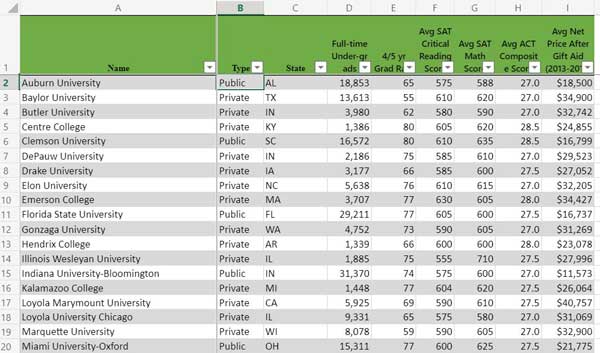 With all of the negative perceptions associated with college testing (ACT and SAT), why would I bother to use them to rank 50-50 schools? The most basic reason is that despite the efforts of groups like FairTest.org, the SAT/ACT are still a fact of life for most high school students.
With all of the negative perceptions associated with college testing (ACT and SAT), why would I bother to use them to rank 50-50 schools? The most basic reason is that despite the efforts of groups like FairTest.org, the SAT/ACT are still a fact of life for most high school students.
Test scores still matter
Public universities especially, often admit strictly on a combination of test scores and GPA or class rank. And by the time you’re a senior, test scores are really the only number you have a chance of significantly changing.
There are other reasons people want to identify colleges with highest test scores. One of the major criticisms of US News Best College Rankings using test scores in their rankings is that is measuring “inputs” to an institution, not the institutional effect. Yet, this doesn’t bother a lot of people.
In fact, you often hear of students or parents worrying if the students will be “challenged” enough or have intellectual peers if they go to a lower ranked college or university. So listing the 50-50 colleges with the highest test scores is one way of identify institutions with an acceptable intellectual population according to some people’s definition.
The corollary to this is that it shows that students who could have potentially been accepted at colleges with more name recognition based on test scores, choose to attend other institutions. And while these schools aren’t necessarily the first choice for all of the students who attend them, they can’t all believe that they are going to be less successful in life because they aren’t going to a nationally ranked university or college.
Define high test scores
To create the listing of colleges with highest test scores, I identified all 50-50 schools that had at least one of the median test scores for freshman in the 85th percentile or higher-sort of. The problem is that you don’t necessarily get an exact score for the 85th percentile for the ACT or SAT. I ended up using the following scores based on the available information:
| Test | Percentile | Score |
| SAT | 85 | 1290 |
| ACT | 87 | 27 |
To avoid using scores from too small of a sample size, I only used scores if at least 20% of the freshmen had submitted results for the specific tests. Schools only had to have the minimum score for only one of the tests to be included in the list. This criteria generated a list of 78 colleges.
What kind of colleges are on the list
The colleges with highest test scores are in 27 states with Indiana having the most with seven. Massachusetts and New York came in second with six each, followed by California with five, and Illinois, Texas, Washington, and Wisconsin had four each. There are 47 private schools and 31 public schools.
The list includes 23 Liberal Arts Colleges, 25 Doctoral Universities, and 17 Masters level institutions. The sizes range from 680 full-time undergraduates to over 43,000. Over half of the colleges have fewer than 5,000 full-time undergraduates.
The list below includes all 50-50 schools with at least one test score at or above the parameters I just described. As usual, the five-year graduation rate is used for public schools and the four-year rate for private schools. You can download a complete list of 50-50 schools here.
50-50 Colleges with Highest Test Scores



